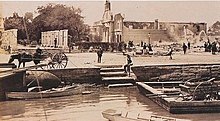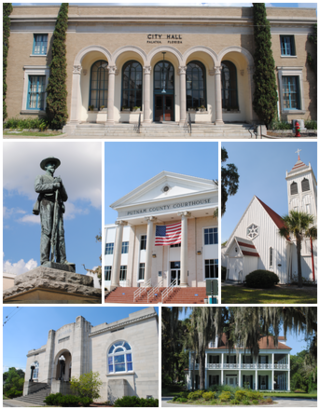
Palatka is a city in and the county seat of Putnam County, Florida, United States. Palatka is the principal city of the Palatka Micropolitan Statistical Area, which is home to 72,893 residents. The city is also home to St. Johns River State College, St. Johns River Water Management District Headquarters, and Ravine Gardens State Park. The area is well known for its local festivals, most notably the Florida Azalea Festival and the Blue Crab Festival. The population was 10,446 at the 2020 census.

St. Augustine is a city in and the county seat of St. Johns County located 40 miles south of downtown Jacksonville. The city is on the Atlantic coast of northeastern Florida. Founded in 1565 by Spanish explorers, it is the oldest continuously inhabited European-established settlement in what is now the contiguous United States.
David Nolan is an American author, civil rights activist, and historian.

Hurricane Dora was the first tropical cyclone on record to make landfall over the Atlantic coast of North Florida at hurricane intensity. The sixth tropical storm and second hurricane of the 1964 season, Dora developed from a tropical wave near the coast of Senegal on August 28. The depression intensified into Tropical Storm Dora late on August 31. It then curved northeastward and continued to strengthen. By late on September 2, Dora became a Category 1 hurricane. Intensification slowed somewhat, with Dora becoming a Category 2 hurricane on September 4 and then a Category 3 hurricane on next day. Deepening further, the storm briefly peaked as a Category 4 with maximum sustained winds of 130 mph (215 km/h) on September 6. Dora soon weakened to a Category 3 hurricane and then a Category 2 hurricane while curving westward early the following day.

The Florida East Coast Railway is a Class II railroad operating in the U.S. state of Florida, currently owned by Grupo México.

The Castillo de San Marcos is the oldest masonry fort in the continental United States; it is located on the western shore of Matanzas Bay in the city of St. Augustine, Florida.
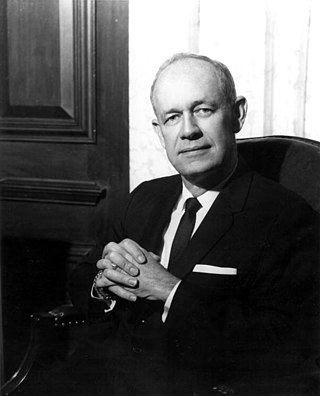
Cecil Farris Bryant was an American politician serving as the 34th governor of Florida. He also served on the United States National Security Council as director of the Office of Emergency Planning during the administration of President Lyndon B. Johnson, who also appointed Bryant chair of the U.S. Advisory Commission on Intergovernmental Relations.
St. Johns River State College is a public college in Northeast Florida with campuses in Palatka, St. Augustine, and Orange Park. Founded in 1958 as St. Johns River Junior College, it is part of the Florida College System and one of several colleges in the system designated a "state college", meaning they can offer more bachelor degrees than traditional community colleges. It is accredited by the Southern Association of Colleges and Schools. Florida School of the Arts, Florida's first state-sponsored arts school, is housed within the Palatka Campus.
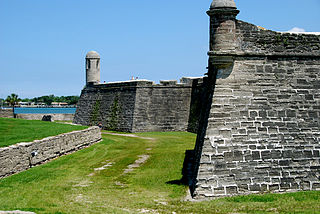
During most of the American Civil War the Florida city of St. Augustine was under Union control. Its Confederate history was exceedingly brief. One Union general and one Confederate general were natives of the Ancient City. Many officers on both sides had previous military experience in St. Augustine, particularly during the Second Seminole War. The city's historic Sea Wall was built in the 1830s, 1840s and 1850s by West Point engineers who went on to design military fortifications for both sides in the Civil War. Many black Union soldiers either came from St. Augustine, or settled there after the war, providing a leadership cadre for the community known as Lincolnville that was established in 1866. Many of the city's old cemeteries feature the distinctive marble tombstones marked "USCT" – United States Colored Troops.

The St. Augustine movement was a part of the wider Civil Rights Movement, taking place in St. Augustine, Florida from 1963 to 1964. It was a major event in the city's long history and had a role in the passage of the Civil Rights Act of 1964.

St. Benedict the Moor School is a former Black Catholic primary school located in the Lincolnville Historic District of St. Augustine, Florida. The school is a contributing property of the Lincolnville Historic District on the National Register of Historic Places.
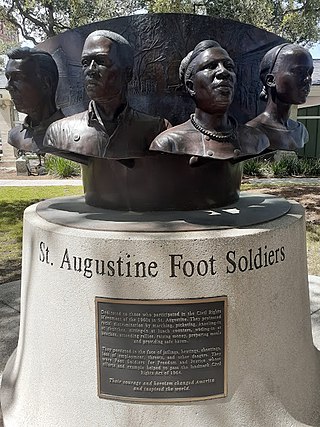
St. Augustine Foot Soldiers Monument is located near the corner of King St. and Charlotte St. in the Southeast corner of the Plaza de la Constitución, a historic public park in downtown St. Augustine, Florida. It is in remembrance of the people who engaged in various forms of peaceful protest in St. Augustine in the early 1960s to advance the cause of civil rights, contributing to the passage of the Civil Rights Act of 1964. The monument, commissioned by the St. Augustine Foot Soldiers Remembrance Project, Inc., was installed and unveiled in May, 2011.
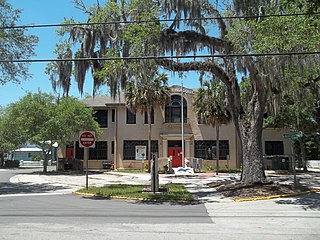
Lincolnville Museum and Cultural Center is an African American history museum located at 102 Martin Luther King Avenue in St. Augustine, Florida. It is located in the former Excelsior School, St. Augustine's first black public high school. The museum opened in 2005.
Robert Bagner Hayling was an American dentist and civil rights activist.
St. Augustine, Florida, the oldest continuously occupied settlement of European origin in the continental United States, was founded in 1565 by Spanish admiral Pedro Menéndez de Avilés. The Spanish Crown issued an asiento to Menéndez, signed by King Philip II on March 20, 1565, granting him various titles, including that of adelantado of Florida, and expansive privileges to exploit the lands in the vast territory of Spanish Florida, called La Florida by the Spaniards. This contract directed Menéndez to explore the region's Atlantic coast and report on its features, with the object of finding a suitable location to establish a permanent colony from which the Spanish treasure fleet could be defended and Spain's claimed territories in North America protected against incursions by other European powers.

St. Augustine's Monastery in Erfurt, central Germany, is a former church and monastery complex dating from the 13th century. The site is almost one hectare in size. It was built by Augustinian friars, an order of the Catholic Church. It is most well known as the former home of Martin Luther (1483–1546), the father of the Reformation, who lived there as a friar from 1505 until 1511.
Herbert Edward Wolfe was an American businessman, banker, philanthropist, farmer, and mayor of St. Augustine, Florida.

The 1964 Monson Motor Lodge protest was part of a series of events during the civil rights movement in the United States which occurred on June 18, 1964, at the Monson Motor Lodge in St. Augustine, Florida. The campaign between June and July 1964 was led by Robert Hayling, Martin Luther King Jr., Ralph Abernathy, Andrew Young, Hosea Williams, C. T. Vivian and Fred Shuttlesworth, among others. St. Augustine was chosen to be the next battleground against racial segregation on account of it being both highly racist yet also relying heavily on the northern tourism dollar. Furthermore, the city was due to celebrate its 400th anniversary the following year, which would heighten the campaign's profile even more. Nightly marches to the slave market were organized, which were regularly attacked and saw the marchers beaten.
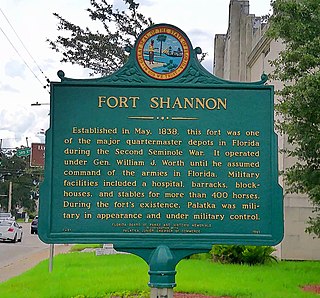
The Indian Removal Act provoked many Seminole Indians and their allies to revolt against being forcibly relocated from their lands and homes in the Florida Territory to Indian Territory west of the Mississippi River. After the Dade Massacre on December 28, 1835, the Second Seminole War was escalated with armed skirmishes and guerilla warfare. Early in the Second Seminole War, the strategically located town of Palatka, Florida Territory was attacked and burned by a group of Seminole Indians and their allies. Most surviving white settlers and black slaves fled to St. Augustine for safety, and the area was mostly abandoned except for free roaming groups of Seminole Indians and their allies. Realizing the importance of a militarily protected and efficient supply line along the St. Johns River General Walker Keith Armistead ordered the main depot moved from Garey's Ferry on Black Creek to Palatka where the U.S. Army built Fort Shannon.

Frank Bertran Butler (1885–1973) was an American businessman who established a beach resort for African Americans in northeast Florida during the segregation era. He worked in Fernandina Beach, St. Augustine, and then St. Augustine's Lincolnville neighborhood where he established his own market as well as a real estate business. He acquired land on Anastasia Island stretching between the Atlantic Ocean and the Matanzas River on which he established a beach area resort open to African Americans. The Tampa Times reported it to be the only beach open to them between the Jacksonville area and Daytona Beach during segregation. It became known as Butler Beach. The unincorporated community and a park in it are named for him.


